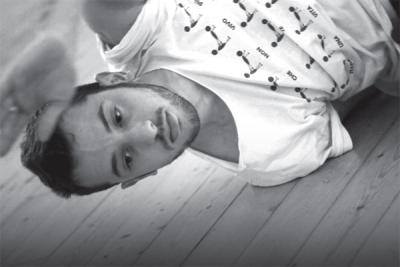Andrea Zardi, performer, chorégraphe, a commencé la danse à l’âge de 16 ans (d’abord le ballet, ensuite des techniques modernes) à Milan et à Florence, en Italie. En 2013, il participe à un festival à Milan dans une galerie d’art. C’est l’occasion pour lui de monter un duo ( Relation – A Bout de Souffle) à partir d’un de ses matériaux de danse préférés, le sujet visuel. Le performer travaille en s’inspirant d’une oeuvre de Giorgio De Chirico (Ulysse’s return). L’occasion de l’interroger sur ses préoccupations artistiques, ce qui le pousse à tisser des liens avec le spectateur, les questionnements qui traversent son travail, les influences, etc. L’une des particularités de son univers tient à la participation active du danseur au processus de création. Ce qui amène notre interlocuteur à établir une distinction subtile entre chorégraphes et performer : « The one dancing totally contributes to his own creation with the author… he must have the ability to compose starting from the task given by the choregrapher… » Andrea conçoit celui qui crée la performance comme un directeur qui garde en tête le résultat final du travail, son sens profond. Le corps intervient comme outil de base dans son travail. Quand on lui demande si l’intelligence du corps est la véritable création qu’un chorégraphe recherche. Andrea répond que le corps détient toutes les réponses : « The body has in itself all the answers we need… it would be time to understand in which direction the intelligence of the body can give us more chances, especially through the techniques we know… »
Il expérimente aussi les potentialités du corps à travers le mouvement, le geste : « I create the movement score starting from a physical track and from an abstract dynamic and I use it later as a draft about the narrative idea or the dramaturgy which I choose. I try to connect everything into a unique meaning to let problems emerge and solve them… » Voilà sa vision de la danse contemporaine, mais la danse tisse aussi des relations avec les autres arts. Andrea Zardi poursuit ses expérimentations à partir des arts graphiques (« I find very stimulating to take inspiration from them and to work on their physical developments… »). Ce qui l’incite à élargir la palette de ses mouvements et d’aller au-delà de la danse : « I work without music, but lately I often used stage noise or, when there are many performers on the scene, I tend to use the breath and the body sounds as an instrument to liberate a lot of energy. Light is a fundamental and powerful mean for scenical writing, especially when you can use projections and shades. It is often difficult to have a good lighting disposal outside theater or in unconventional stages… », déclare le chorégraphe. Ce travail à partir des arts graphiques, utilisant le plateau, la musique, la lumière, vise à mettre en valeur le regard du spectateur. Andrea va plus loin en parlant de sa danse-théâtre comme un espace ouvert. Le « performing art » doit établir le contact avec les gens. « Dance is too often made for the dancers and not for the audience. Dancers are often afraid of being clear and direct in giving a specific meaning to their performance. The verb I prefer is « to feel, which means the strenght of a practice which puts people in contact… » Et quand on l’interroge sur des situations allant du jeu théâtral à des techniques psychanalytiques, Andrea Zardi se livre aux questionnements qui traversent son travail : « I am writing a thesis on the activity of Mirror-neuron system in response to dance motricity stimulation… why does the spectator feels an emotion while looking at a performer doing an action – even a simple one – even if is not telling a story? I started from the studies about mirror-neuron which recently had a great success. I started from what the spectator feels in relation to what the performance wants to say to the spectator avoinding abstractions… » Ses recherches sur le « mirror-neuron » deviennent ainsi le miroir abstrait (au-delà du langage verbal) des émotions du spectateur face à la performance. Et quels sont les chemins que cet artiste emprunte? Andrea insiste, en parlant de ses séquences dansées, sur l’impulsion physique, la répétition, le réflexion, les tentatives, les échecs : « I know I am on the right way when I realize I am not able to put into practice what I have in mind, so I am obliged to find a physical solution for what I built. I think it is useful to go through « forcing » a movement… », nous dit-il. Si Andrea Zardi explore le mouvement, les signaux qu’émet le corps, le rythme, il cherche aussi tout ce qui peut nourrir le travail comme l`approche poétique du corps: « The fundative principle of my creation is impressing some movements through improvisation skills: free movement produces emotion and a sort of « poetry of the body. This is not an aestethics concept, but really a concrete way to have a impulsive result. A simple, formal and concrete movement is more effective that any gestures acting… »
Voilà les différences de point de vue dans sa recherche chorégraphique. Il semble évident pour ce performer d`expérimenter, de mettre constamment en jeu ses repères.
PORTRAIT (ANDREA ZARDI) : La performance, miroir abstrait des émotions
- Publicité -
EN CONTINU ↻
- Publicité -

